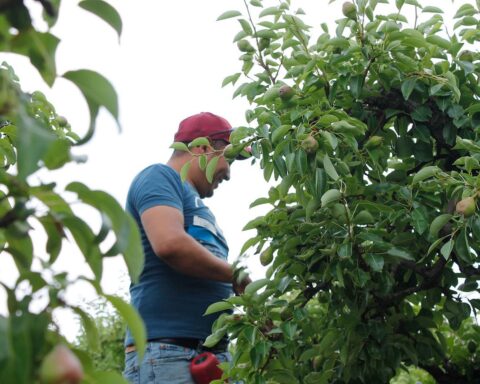Paid sick leave, affordable childcare, reform of the Employment Insurance system, better-quality jobs and higher minimum wage are some of the elements needed to ensure an inclusive recovery from the COVID-19 pandemic, which has hit visible minorities and immigrants the hardest, according to ethnic media coverage of the economic impacts of COVID-19.
Especially early into the pandemic, visible minorities and recent immigrants were more impacted by job losses, inability to meet financial obligations and essential needs than white Canadians and long-term immigrants or Canadian-born population, showed several studies cited in the media, as analyzed from May to December 2020.
The July Labour Force Survey (for the first time based on data disaggregated by race and visible minority status) showed that the unemployment rate was higher for South Asian, Arab, and Black Canadians, which Statistics Canada linked to higher representation of these minorities in hard-hit industries such as food services and retail. Immigrant women were also shown to be disproportionately affected by the pandemic.
- Overview of ethnic media coverage
- Comparative analysis with mainstream media
- Word from our partner, MIREMS
- Commentary from the NCM Collective
Questions around lockdowns
As the second wave of the pandemic brought with it new lockdowns (Toronto and Peel region moved into lockdown on November 23, and a province-wide shutdown in Ontario has been in effect since December 26), the media gave voice to those questioning the effectiveness of such measures in places where most infections happen in industrial and essential workplace settings, like the city of Brampton.
Mayor of Brampton Patrick Brown was one of the most often cited critical voices, who called the forced closure of small businesses “tinkering around the edges.” Multiple outlets cited Brown as saying that the lockdown in Peel Region was not likely to dramatically reduce the number of new COVID-19 infections in Brampton without other supports in place: better sick benefits, an isolation centre, and better access to testing.
He stressed that staff in factories and front-line workers lose their paycheque if they do not come to work, so many are forced to choose between going to work with symptoms and making the rent payment or putting food on the table.
Sick leave: the missing link in pandemic response
In late November, Brown made headlines with an appeal by a group of Greater Toronto and Hamilton Area (GTHA) mayors to the province of Ontario for sick leave benefits for front-line workers. Brampton mayor called the benefits “a missing link” in the pandemic response. As reported, the mayors also asked the provincial government to sign an agreement with employers, reassuring employees that they would not lose their jobs or their salary if they tested positive for COVID-19.
Pressure for sick days came from many sides. A widely cited September report by the researcher ICES found not only that immigrants, refugees and other newcomers accounted for a whopping 44 per cent of all COVID-19 cases in Ontario in the first half of 2020 but also that many immigrants and refugees faced systemic inequities including lower pay and precarious employment without the right to sick leave.
The systemic inequities like the fact that many essential workers cannot afford to self-isolate away from their families need to be addressed, Regional Councillor in Brampton Rowena Santos said in an interview with one of the outlets in November, calling for better access to healthcare, higher quality jobs, sick days and higher minimum wage.
In late November, the media carried a message from Health Minister Patty Hajdu, who said the federal government was working with provinces and territories on sick leave. She admitted it was necessary to have low-barrier access to Employment Insurance (EI) for those working on the front lines, and that workers can be eligible for EI with 170 hours of work.
Calls for EI reform
Problems with accessing EI, especially by underemployed workers and expectant mothers for whom the pandemic-induced job cuts meant not enough working hours to qualify for benefits, prompted calls for the reform of the outdated EI system early on.
A Workers’ Action Centre activist cited in ethnic media in August pointed to the situation of the underemployed, especially restaurant staff and people in the tourism industry, who did not have working hour guarantees in their contracts and who may not be able to obtain a record of employment to access EI when the Canada Emergency Response Benefits (CERB) end. He also pointed to self-employed workers such as Uber drivers or people working in food delivery services
“She-covery” and the importance of childcare
Women, especially racialized women, are over-represented in precarious, low-paying jobs, so the COVID-19 pandemic has had a disproportionate economic impact on them, as demonstrated by various reports cited in multiple ethnic media outlets. A September report by the Ontario Chamber of Commerce entitled “The She-Covery Project” pointed out that women’s labour participation rate had fallen to its lowest in 30 years.
Reports that female immigrants, especially working in health care, were hit especially hard by the pandemic have prompted calls for policies instituting higher pay, paid sick leave, universal childcare and eldercare, and affordable housing.
Since mothers were usually the ones losing their jobs or staying home to take care of the children during the pandemic, the central role of affordable daycare in the economic recovery plans was stressed by the media and the policymakers alike, including in a slew of December media appearances by the Minister of Families, Children and Social Development, Ahmed Hussen. Hussen promised the federal government would create a nationwide childcare program, with details to come in the spring of 2021.
“Shop local” campaign to support small businesses
The struggles of small businesses, often owned by immigrants or visible minorities, also featured strongly in ethnic media coverage, with the newest lockdowns bringing renewed fears of severe economic impacts, but few solutions in sight.
The media stressed that while small businesses like hair salons were forced to close their doors, big retailers like Amazon were allowed to operate. One of the victims of the pandemic featured in October was a Black owner of a beauty parlour who was ineligible for government support, as she had opened her salon only in 2020.
The prospects for small businesses appeared bleak yet in August. Jon Shell, managing director at Social Capital Partners and a co-founder of the Save Small Business campaign, was cited as saying that “the recovery looks like it will be very weak for local community businesses, making additional cash flow hard to come by over the rest of the year. Many will not survive.”
Patrick Brown admitted back in May that the pandemic was an “economic firestorm,” and the small stores and businesses were especially badly affected. He called on Brampton residents to support them by shopping locally and ordering take-out food from restaurants in their neighbourhoods. A similar appeal by Ontario Premier Doug Ford was aired in October. The media also reported on Ontario’s NDP Leader Andrea Horwath’s Save Main Street plan, supported by the Canadian Black Chamber of Commerce (CBCC).
The government’s commercial rent assistance program was criticized as ineffective: few landlords decided to participate, as that would have forced them to cover 25 per cent of the rent.
Coverage of other government programs addressed to small businesses was rather limited. Apart from announcements of subsequent extensions of the wage subsidy program, the Canada Emergency Business Account was mentioned only once in a collection of around 200 media clippings—in the context of the government’s recovery plan presented in early December by Minister Hussen.
Comparative analysis with mainstream media
The analysis of Toronto Star coverage was focused on the pandemic’s impact on small businesses. More than half of the articles discussing challenges faced by different types of businesses showcased those owned by immigrants and many told their stories of going through the painful process of closing down permanently.
A lot of coverage was also devoted to government measures and how businesses can access them, for example the Canada Emergency Business Account. Different polls and appeals from business advocacy groups and other stakeholders for the government to do more to help small business owners were also featured.
Like ethnic media, the paper discussed the unfair advantage during lockdown of big-box stores over small businesses. Unlike ethnic media, it also covered the spike in insurance premiums as one of the key factors that forced many businesses to shut down.
In terms of navigating the difficulties of the pandemic, the Star also presented various innovations such as ghost kitchens, a business incubator called District Ventures Kitchen, and other new approaches to doing business in food service.
Insight from MIREMS media monitoring
 Ethnic media “can be expected to become an important voice for ethnically inclusive recovery initiatives,” commented Silke Reichrath, Editor-in-Chief at MIREMS.
Ethnic media “can be expected to become an important voice for ethnically inclusive recovery initiatives,” commented Silke Reichrath, Editor-in-Chief at MIREMS.
“The coverage showed time and again how newcomers often work in essential jobs, which makes them more susceptible to virus exposure,” she stressed. Sectors in focus that rely heavily on newcomers included the taxi industry, the hotel and tourism sector, meat processing plants, long-term care and health care.
Overall, ethnic media have kept their audiences informed about the latest public health guidelines about business openings and closures and about benefits and aid programs available from the three levels of government, Reichrath said.
“They have also raised awareness in general about how the pandemic is affecting the national and local economy, have featured charitable initiatives by the community, and have encouraged community members to support local businesses by buying local, particularly from smaller businesses,” she added.
Methodology: This ethnic media analysis is based on a selection of 200 summaries of articles and broadcast segments in radio, TV, print and web sources between May and December, 2020, with special focus on the last six months of last year. These summaries were found in 450 active ethnic media sources monitored by MIREMS.
For mainstream media analysis, the ProQuest Databases Platform was searched using the keywords “business owners” and “COVID-19.” A total of 181 articles published in Toronto Star from July 1 to Dec. 31, 2020 were included for review.
Commentary from the NCM Collective
 Tunde Asaju (African-Canadian): Prime Minister Justin Trudeau’s September announcement of a $221 million program to help black businesses access loans was welcome with both gratitude and scepticism in the Black business community. Of the amount, $6.5 million was designed to help the government collect data on the state of Black businesses. This is the first time that is being done in Canada. Five months in, the outcome is still being awaited. Black and minority businesses often complain that even in normal times, they fared worse than their white counterparts.
Tunde Asaju (African-Canadian): Prime Minister Justin Trudeau’s September announcement of a $221 million program to help black businesses access loans was welcome with both gratitude and scepticism in the Black business community. Of the amount, $6.5 million was designed to help the government collect data on the state of Black businesses. This is the first time that is being done in Canada. Five months in, the outcome is still being awaited. Black and minority businesses often complain that even in normal times, they fared worse than their white counterparts.
Nadine Spencer, President of the Black Business and Professional Association, believes that if the Trudeau plan is to make an impact, it must be race inclusive, measurable, and have a rated impact, she told the Calgary edition of the Star. A November article by the University of Toronto sociology professor Njoki Wane argued that COVID-19 has led to the closure of old-time Black businesses in parts of Toronto that were first affected by infrastructure enhancements, then slammed by the virus.
 Arpan Chahal (Punjabi): The Punjabi community work in various roles in diverse industries, however, a huge segment of the community have built their livelihoods by establishing businesses in food services, transportation and trucking industry, real estate, construction, and retail. Unfortunately, small businesses have taken the hardest hit from COVID-19. Surveys indicate that one in ten restaurants in the country have closed permanently due to the pandemic, including many owned and run by Punjabis. With the international border between Canada and the U.S. largely closed, the transport industry which employs thousands of Punjabis has been hit badly for almost a year now.
Arpan Chahal (Punjabi): The Punjabi community work in various roles in diverse industries, however, a huge segment of the community have built their livelihoods by establishing businesses in food services, transportation and trucking industry, real estate, construction, and retail. Unfortunately, small businesses have taken the hardest hit from COVID-19. Surveys indicate that one in ten restaurants in the country have closed permanently due to the pandemic, including many owned and run by Punjabis. With the international border between Canada and the U.S. largely closed, the transport industry which employs thousands of Punjabis has been hit badly for almost a year now.
A series of lockdowns stripped away thousands of survival jobs, which were often the only source of income for new immigrants and international students. New immigrants, those who did not have the documents to prove employment and those who were self-employed, were unable to qualify for government support. As soon as the international flights became operational, many Punjabi students, especially from Ontario and British Columbia, went back to India because they were unable to afford their expenses, pay rent and tuition fees.
 Christopher Chanco (Filipino-Canadian): The economic troubles faced by both Filipino-Canadian small businesses and migrant workers have been covered extensively by the Filipino diaspora press. Balitang Amerika, for one, has pointed to the impacts of the pandemic on Filipino migrants in the tourism and retail sectors. In one video, a small business owner is quoted as saying that she feared economic losses more than the virus itself.
Christopher Chanco (Filipino-Canadian): The economic troubles faced by both Filipino-Canadian small businesses and migrant workers have been covered extensively by the Filipino diaspora press. Balitang Amerika, for one, has pointed to the impacts of the pandemic on Filipino migrants in the tourism and retail sectors. In one video, a small business owner is quoted as saying that she feared economic losses more than the virus itself.
In Alberta, some Filipino workers have been left stranded by the provincial government’s decision to stop hiring temporary foreign workers to prioritise citizens in key sectors like retail and construction. Finally, while mainstream publications have covered the impacts of the pandemic on diaspora remittances to the Philippines, critical to the Filipino economy, there is surprisingly little coverage on this issue in the diaspora press, apart from syndicated articles.
 Shalaw Fatah (Iraq/Arabic): Arabic outlets have depicted a gloomy picture for small businesses and workforce due to COVID-19, but they’ve also tried to give hope to people by publishing some good news. Sada al-Mashreq says local compensation funds do not cover people’s expenses. On the good-news side, the outlet says while Quebec announced a month-long lockdown, there is an exception for work-related activities, small business matters and delivery workers. Meshwar Media says while new regulations are introduced in Ontario, a frightening and worrisome rise of COVID-19 threatens the community. On the good-news side, it reports while the economic situation will be difficult in the short run, major bank executives promise an economic boom in the long run. Al-Bilad newspaper says core retail sales decreased for the fifth month late last year as new waves of COVID-19 hit the market. AKHBAR CANADA notes that the Canadian government asked international students to remain in Canada and find jobs.
Shalaw Fatah (Iraq/Arabic): Arabic outlets have depicted a gloomy picture for small businesses and workforce due to COVID-19, but they’ve also tried to give hope to people by publishing some good news. Sada al-Mashreq says local compensation funds do not cover people’s expenses. On the good-news side, the outlet says while Quebec announced a month-long lockdown, there is an exception for work-related activities, small business matters and delivery workers. Meshwar Media says while new regulations are introduced in Ontario, a frightening and worrisome rise of COVID-19 threatens the community. On the good-news side, it reports while the economic situation will be difficult in the short run, major bank executives promise an economic boom in the long run. Al-Bilad newspaper says core retail sales decreased for the fifth month late last year as new waves of COVID-19 hit the market. AKHBAR CANADA notes that the Canadian government asked international students to remain in Canada and find jobs.
 Tazeen Inam (Urdu): The Pakistani media in Canada have painted a gloomy picture of economic struggles of the community as the pandemic entered a new phase, with new lockdowns. Besides featuring the overall job loss situation, media mostly focused on the CERB eligibility criteria. Akhbar-e-Pakistan called to attention the grievances of refugees who faced acute shortage of financial support.
Tazeen Inam (Urdu): The Pakistani media in Canada have painted a gloomy picture of economic struggles of the community as the pandemic entered a new phase, with new lockdowns. Besides featuring the overall job loss situation, media mostly focused on the CERB eligibility criteria. Akhbar-e-Pakistan called to attention the grievances of refugees who faced acute shortage of financial support.
Small businesses were badly affected and were unable to apply for Government support, as most of them are run by family members and do not meet the criteria of number of employees. Restaurants and food businesses in the community are struggling to survive by advertising on social media. Among women, a good number are in daycare businesses and these too have been running with lower than minimum revenues. People have complained about the rising prices of basic commodities. Some said that they are living hand to mouth. On average, the number of income-earners per household has fallen to one from two to three before, depending on the number of adults in the family.
 Isabel Inclan (Hispanic): With many businesses in the Spanish speaking community closed, the Hispanic media are reporting more about the pandemic situation (number of cases, vaccinations) than the direct impact of the lockdowns on the businesses. In many cases, the Hispanic media content is linked to business (due to advertising), but with minimum economic activity as a result of the COVID-19, the media are more focused on the pandemic, education, nutrition, ways to survive the lockdown, and international news.
Isabel Inclan (Hispanic): With many businesses in the Spanish speaking community closed, the Hispanic media are reporting more about the pandemic situation (number of cases, vaccinations) than the direct impact of the lockdowns on the businesses. In many cases, the Hispanic media content is linked to business (due to advertising), but with minimum economic activity as a result of the COVID-19, the media are more focused on the pandemic, education, nutrition, ways to survive the lockdown, and international news.
The negative impact of the pandemic is visible in the Hispanic media landscape itself. Most of the outlets have had to reduce coverage, stop printing on paper, reduce their staff, and go digital. Some Hispanic media dedicated to entertainment had to change their content to other fields such as immigration, health, and economic support from the government.
 Marcus Medford (Caribbean): Early on, organizations like the Black Business and Professional Association (BBPA) and the Canadian Black Chamber of Commerce (CBCC) were tracking how the pandemic was affecting Black-owned businesses. The CBCC identified 20,000 Black-owned businesses and estimated that 70 per cent of them wouldn’t qualify for the Canada Emergency Business Account (CEBA). The report also mentioned that the majority of Black-owned businesses were in the service sector, which has been devastated by COVID-19. According to a BBPA survey, 80 per cent of Black businesses don’t believe the Canada Emergency Wage Subsidy (CEWS) will be enough to help them survive, compared to 37 per cent of all businesses. As many as 85 per cent of Black owners worried about being forced to close their businesses permanently, versus 39 per cent overall.
Marcus Medford (Caribbean): Early on, organizations like the Black Business and Professional Association (BBPA) and the Canadian Black Chamber of Commerce (CBCC) were tracking how the pandemic was affecting Black-owned businesses. The CBCC identified 20,000 Black-owned businesses and estimated that 70 per cent of them wouldn’t qualify for the Canada Emergency Business Account (CEBA). The report also mentioned that the majority of Black-owned businesses were in the service sector, which has been devastated by COVID-19. According to a BBPA survey, 80 per cent of Black businesses don’t believe the Canada Emergency Wage Subsidy (CEWS) will be enough to help them survive, compared to 37 per cent of all businesses. As many as 85 per cent of Black owners worried about being forced to close their businesses permanently, versus 39 per cent overall.
The Caribbean Camera highlighted the fact that many BIPOC were already facing financial hardships, and the pandemic has simply exposed and exacerbated them. The paper also wrote that many Black businesses have been unable to receive funding through traditional financial channels like banks because of systemic anti-Black racism. The burden on Black women was also highlighted, as they often work as RNs, teachers and PSWs, and tend to be paid less than both their male and white counterparts. In the Toronto Caribbean, one of the columnists criticized the federal government’s Black Entrepreneurship Fund for being discriminatory against new businesses. They also said it was uncertain how many businesses would survive long enough to benefit.
 Shan Qiao (Chinese): Media focused on the rapid bounce-back of Chinese restaurants because the community adopted health measures early. Before the first reported Toronto case on Jan 25, 2020, Chinese restaurants experienced a hard hit like they had with the 2003 SARS outbreak. Singtao Daily also reported on the Chinese comunity’s faster response to stop the spread of COVID-19, claiming countermeasures helped restaurant businesses recover sooner. Meanwhile, the scarcity of sanitizers and masks at the beginning of the outbreak quickly made Chinese supermarkets carrying the supplies gain media attention, as did their price gouging.
Shan Qiao (Chinese): Media focused on the rapid bounce-back of Chinese restaurants because the community adopted health measures early. Before the first reported Toronto case on Jan 25, 2020, Chinese restaurants experienced a hard hit like they had with the 2003 SARS outbreak. Singtao Daily also reported on the Chinese comunity’s faster response to stop the spread of COVID-19, claiming countermeasures helped restaurant businesses recover sooner. Meanwhile, the scarcity of sanitizers and masks at the beginning of the outbreak quickly made Chinese supermarkets carrying the supplies gain media attention, as did their price gouging.
Chinese media headlines often featured news of the government’s financial aid. MingPao Daily News published an online survey initiated by Vancouver-based Canada Committee 100 Society and Innovative Research Group last July. The survey found that out of 579 Chinese-Canadians surveyed, 45 per cent were worried they could not make the next mortgage payment, nine per cent higher than the general public. Fifty per cent worried they could not pay next month’s rent, 14 per cent higher than the general public. A researcher was quoted as saying, “Many people look at Chinese immigrants as wealthy, who live in big houses and drive expensive cars. They think Chinese immigrants don’t have to face the same economic difficulties. The latest survey has broken this stereotype.”
 Pradip Rodrigues (South Asian): With South Asian immigrants it is hard to tell the real impact as many have availed of government subsidies and business loans. Many small restaurant owners have been hit and fear for their businesses once subsidies are phased out. Many families are relying on their real estate investment and rental income. That includes hundreds of South Asians who work as realtors, also to scour investment properties which they buy without having to pay a commission. They have been unable to find houses in the current economic climate.
Pradip Rodrigues (South Asian): With South Asian immigrants it is hard to tell the real impact as many have availed of government subsidies and business loans. Many small restaurant owners have been hit and fear for their businesses once subsidies are phased out. Many families are relying on their real estate investment and rental income. That includes hundreds of South Asians who work as realtors, also to scour investment properties which they buy without having to pay a commission. They have been unable to find houses in the current economic climate.
 Vladimir Umnov (Russian): The newspaper Russian Express checked the incomes of top managers of Canadian corporations and criticized the fact these incomes did not decrease in 2020. According to Vancouverok.com, the gap between ordinary people and managers continues to increase. It is a popular subject to discuss in the Russian community. Russian-speaking media rather don’t discuss any issues faced by Russian-owned businesses.
Vladimir Umnov (Russian): The newspaper Russian Express checked the incomes of top managers of Canadian corporations and criticized the fact these incomes did not decrease in 2020. According to Vancouverok.com, the gap between ordinary people and managers continues to increase. It is a popular subject to discuss in the Russian community. Russian-speaking media rather don’t discuss any issues faced by Russian-owned businesses.
Russian-speaking social media users discuss details of CERB and CRB benefits regularly. According to comments on social media, the CERB allowed people not to look for a job last year. Many community members said they were happy to stay at home.
This NCM media analysis has been produced with funding support from the Digital Citizen Contribution Program.
Read Part 1: COVID-19 Vaccine Hesitancy Amplified by Small Section of Ethnic Media
Read Part 2: Unsung Heroes or Super Spreaders: Racial and Ethnic Minorities in COVID-19 Coverage
Read Part 3: About “Cheap Immigrant Labour” and “Student Cash Cows”
Alicja Minda is an NCM journalist, editor and researcher with extensive experience covering business and economy as well as global affairs. She has worked as Canada correspondent for the Polish Press Agency. In her free time, she is volunteering with Editors Canada as editor-in-chief of the Editors Toronto official blog, BoldFace.
Naser Miftari is an independent media researcher. His broad area of interest is in political theory and his research focus is on the future of public broadcasting, media governance and political economy of communication. For more than ten years he was a writer and editor for Koha Ditore one of leading newspapers in South East Europe. He is an active contributor in media research studies and has also taught graduate and undergraduate courses in media and political science at colleges and universities in United States and South East Europe. More recently he served as a contributor on global journalism issues with the Toronto-based Canadian Journalists for Freedom of Expression (CJFE) and in 2016 he was a research fellow at King’s College in New York.






